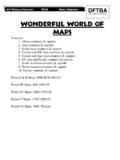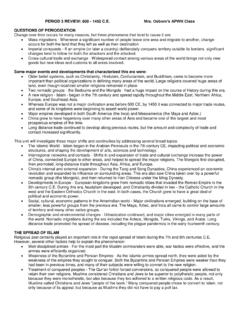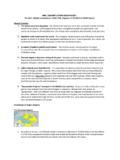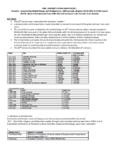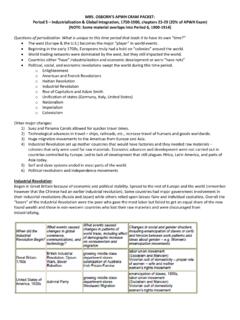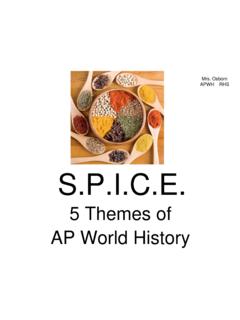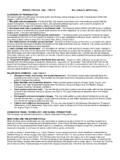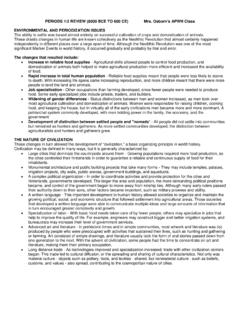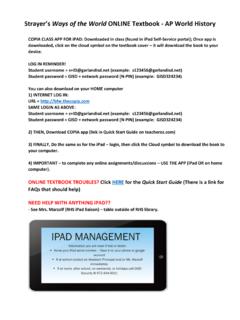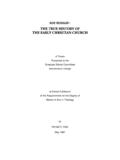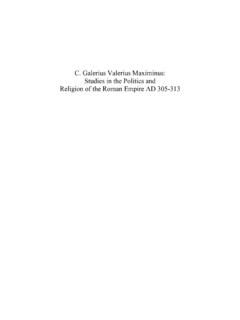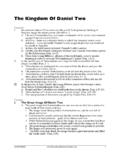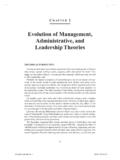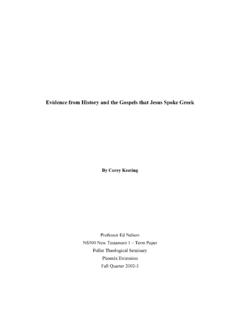Transcription of MRS. OSBORN’S APWH CRAM PACKET: Period 1 …
1 MRS. OSBORN S APWH CRAM PACKET: Period 1 technological & environmental Transformations, to 600 , chapters 1-3 (5% of the APWH Exam) Period 2 Organization & Reorganization, 600 600 , chapters 4-9 (15% of the APWH Exam) Climate Climate has been a major factor in determining where people settled. Peopled settled in areas that has climates that would accommodate agriculture and livestock. Time periods The Paleolithic Age refers to about 12,000 BC. During this time people were nomadic. The Neolithic Age refers to the age from about 12,000 BC to about 8000 BC. It is during this time that people settled in communities and civilization began to emerge. River Valley Civilizations refers to about 3500 to 1500 BC.
2 The major River Valleys are described below. Classical Civilizations refers to about 1000 BC to 600 CE. The major civilizations to emerge were Zhou and Han China, Greece and Rome, and the Gupta Empire. THE RIVER-VALLEY CIVILIZATIONS Each early civilization developed its own unique ways of life, but they all shared some common characteristics Complex irrigation systems legal codes money art and written literature More formal scientific knowledge, numbering systems, and calendars Intensification of social inequality COMPARISONS OF EARLY RIVER VALLEY CIVILIZATIONS CULTURE POLITICAL ORGANIZATION SOCIAL STRUCTURE MESOPOTAMIA (developed by 3500 BCE) Cuneiform; Extensive trade with Egypt & the Indus Valley Epic of Gilgamesh Early use of bronze tools, chariots Advanced astronomy.
3 Math based on 60 Pessimistic view of the world, perhaps due to irregular, unpredictable flooding of the Tigris & Euphrates rivers Polytheism gods powerful/cruel Kings powerful, but not divine RIVERS: Tigris & Euphrates City-states & warrior kings Hammurabi s Code Competition among city-states as well as frequent invasions led to less political stability than in Egypt Job specialization farmers, metallurgists, merchants, craftsmen, political administrators, priests Social classes Marriage contracts; veils for women; women of upper classes less equal than lower-class counterparts EGYPT (developed by 3000 BCE) Concerned with decorative arts, ship-building, some medical knowledge Less advanced in math & astronomy than Mesopotamians Less extensive trade.
4 Polytheism, with pharaoh as a god Optimistic view of life (regular, controllable flooding of the Nile River) Strong belief in the afterlife; Book of the Dead Hieroglyphics complex pictorial language. RIVER: Nile Divine kingship the pharaoh; highly centralized, authoritarian government Generally stable government throughout the 3 kingdoms Extensive bureaucracy; pharaoh s power channeled through regional governors Smaller nobility than Mesopotamians; fewer merchants Some social mobility through the bureaucracy Priests have high status (only ones that understand the complex hieroglyphic written language) Women probably higher status than in Mesopotamia; love poetry indicates some importance placed on male/female relationships One female pharaoh Hatshepsut Influential wife of pharaoh - Nefertiti INDUS VALLEY (developed by 2500 BCE) Writing system undecipherable Soapstone seals indicate trade with both Mesopotamia & China Cruder weapons than Mesopotamians stone arrowheads, no swords Polytheism naked man with horns primary god; fertility goddesses Two cities: Harappa & Mohenjo-Daro RIVER: Indus Assumed to be complex & thought to be centralized Limited information, but large granaries, plumbing, and cities designed on grid pattern indicate centralized control Priests have highest status based on position as intermediaries between gods and people.
5 Differences in house sizes indicate class distinctions Statues reflect reverence for female reproductive function SHANG CHINA (developed by 1700 BCE) Oracle bones used to communicate with ancestors Patterns on bones formed basis for writing system; writing highly valued, complex pictorial language with 3000 characters by end of dynasty Uniform written language became bond among people who spoke many different languages Bronze weapons & tools, horse-drawn chariot Geographical separation from other civilizations (Gobi Desert & Himalaya Mts.), though probably traded with the Indus Valley RIVER: Huang He (Yellow) Centralized government; power in the hands of the emperor Government preoccupied with flood control of the rivers (Huang He & Yangtze) Job specialization bureaucrats, farmers, slaves Social classes warrior aristocrats, bureaucrats, farmers, slaves Patriarchal society women as wives & concubines; women sometimes shamans MESO AND SOUTH AMERICA (developed by 1200 BCE) Olmecs in Mesoamerica; Highly developed astronomy; used to predict agricultural cycles & please the gods.
6 Polytheism; religious rituals important, shamans as healers Ritual ball games Irrigation & drainage canals Giant carved stone heads, probably with religious significance Jaguar symbol important Chavin in Andean region Polytheism statues of jaguar men Square stone architecture, no mortar Well-developed agriculture based on maize Unique geography: lived on coast, in mountains, and in jungle Olmecs: apparently not united politically; unusual for ancient civilizations Chavin: probable political unification; public works operated by reciprocal labor obligations; had a capital city Olmec: craft specializations; priests have highest status; most people were farmers Chavin: priests have highest status; capital city dominated hinterlands; most people were farmers Economic Systems Classical Civilizations COMMON FEATURES OF CLASSICAL CIVILIZATIONS The three areas of classical civilizations developed their own beliefs, lifestyles, political institutions, and social structures.
7 However, there were important similarities among them: Patriarchal family structures - Like the river valley civilizations that preceded them, the classical civilization valued male authority within families, as well as in most other areas of life. Agricultural-based economies - Despite more sophisticated and complex job specialization, the most common occupation in all areas was farming. Complex governments - Because they were so large, these three civilizations had to invent new ways to keep their lands together politically. Their governments were large and complex, although they each had unique ways of governing Expanding trade base - Their economic systems were complex. Although they generally operated independently, trade routes connected them by both land and sea.
8 COMPARISONS OF CLASSICAL CIVILIZATIONS CULTURE POLITICAL ORGANIZATION SOCIAL STRUCTURE GREECE (about 800-300 BCE) Most enduring influences come from Athens: Valued education, placed emphasis on importance of human effort, human ability to shape future events Interest in political theory: which form of government is best? Celebration of human individual achievement and the ideal human form Philosophy & science emphasized Highly developed form of sculpture, literature, math, written language, & record keeping Polytheism, with gods having many human characteristics Cities relatively small Great sea-faring skills, centered around the Aegean, but traveling around entire Mediterranean area. No centralized government; concept of polis, or a fortified site that formed the centers of many city-states Governing styles varied (Sparta a military state, Athens eventually democracy for adult males) Athens government first dominated by tyrants, strong rulers who gained power through military prowess; later came to be ruled by an assembly of free men who made political decisions.
9 Both Athens & Sparta developed strong military organizations and established colonies around the Mediterranean. Sparta theoretically equal, wealth accumulation not allowed Slavery widely practiced Sparta - Men separated from women in military barracks until age 30; women had relative freedom; women in Sparta encouraged to be physically fit so as to have healthy babies; generally better treated and equal to men than women in Athens Athens encouraged equality for free men, but women and slaves had little freedom. Neither group allowed to participate in polis affairs Social status depended on land holdings and cultural sophistication ROME (about 500 BCE to 476 CE, although eastern half continued for another thousand years) Perfection of military techniques: conquer but don't oppress; division of army into legions, emphasizing organization and rewarding military talent Art, literature, philosophy, science derivative from Greece Superb engineering and architecture techniques; extensive road, sanitation systems; monumental architecture -buildings, aqueducts, bridges Polytheism, derivative from Greeks, but religion not particularly important to the average Roman.
10 Christianity developed during Empire Period , but not dominant until very late Great city of Rome - buildings, arenas, design copied in smaller cities Two eras: Republic - rule by aristocrats, with some power shared with assemblies; Senate most powerful, with two consuls chosen to rule, generally selected from the military Empire - non-hereditary emperor; technically chosen by Senate, but generally chosen by predecessor Extensive colonization and military conquest during both eras Development of an overarching set of laws, restrictions that all had to obey; Roman law sets in place principle of rule of law, not rule by whim of the political leader Basic division between patricians (aristocrats) and plebeians (free farmers), although a middle class of merchants grew during the empire; wealth based on land ownership; gap between rich and poor grew with time Paterfamilias - male dominated family structure Patron-client system with rich supervising elaborate webs of people that owe favors to them Inequality increased during the empire, with great dependence on slavery during the late empire; slaves used in households, mines, large estates, all kinds of manual labor CHINA (about 500 BCE 600 CE) Confucianism developed during late Zhou.
